Numerical Research on Migration Law of Typical Chlorinated Organic Matter in Shallow Groundwater of Yangtze Delta Region
Abstract
:1. Introduction
2. Information on the Study Site
2.1. Description of the Study Site
2.2. Data Measurement and Collection from the Site
2.3. Hydrogeological Conditions of the Site
2.4. Survey of Groundwater Contamination
3. Methodology
3.1. Research Process
3.2. Groundwater Flow Equation
3.3. Contaminant Transport Equation
3.4. Parameter Sensitivity Analysis Method
4. Construction of the Numerical Model
4.1. Numerical Simulation of Groundwater Flow
4.1.1. Hydrogeological Structure Generalization
4.1.2. Model Discretization
4.1.3. Boundary Condition
4.1.4. Initial Conditions and Parameter Setting
4.2. Flow Model Verification and Calibration
4.3. Numerical Simulation of Groundwater Contaminant Transport
5. Results and Discussion
6. Results of Sensitivity Analysis
7. Conclusions
- (i)
- In the microconfined aquifers of the Yangtze River Delta, the natural migration rate of pollutants is slow, and large-scale diffusion and migration will not occur in the short term. Therefore, during the groundwater remediation of similar pollution sites, the horizontal migration of pollutants usually does not pose a serious risk. However, to prevent the further expansion of the pollution range, corresponding anti-seepage barriers can be established according to on-site pollution monitoring results to inhibit the migration of pollutants.
- (ii)
- During the groundwater remediation process, soil remediation and backfilling often occur. Microconfined aquifers have a certain pressure, so attention should be paid to the secondary pollution to the upper clean soil layer caused by pollutants under capillary force and pressure. To avoid this situation, appropriate underground isolation barrier measures, such as geotextile membrane barriers and concrete wall barriers, can be taken.
- (iii)
- The present study’s parameter sensitivity analysis offers valuable insights into groundwater remediation. Notably, the hydraulic conductivity of soil exhibits a positive correlation with the extent of contamination and vertical migration. This finding emphasizes the importance of employing high-efficiency remediation technologies, such as activated carbon adsorption and chemical oxidation, in high hydraulic conductivity areas to effectively mitigate pollution. Conversely, in low hydraulic conductivity areas, cost-effective and practical remediation methods, such as bioremediation, may suffice. Additionally, this study highlights the fact that increased summer rainfall can worsen pollutant migration, emphasizing the importance of targeted interventions. For instance, drainage and interception facilities can be installed around the remediation site to intercept and collect precipitation and groundwater, thereby minimizing the downward migration of pollutants. Furthermore, suitable pollutant adsorbents can be incorporated into the soil to absorb pollutants and impede their downward migration.
- (iv)
- The research object of this paper is the microconfined aquifer of a contaminated site in the Suzhou area. This site is located in the city, and the pollution control boundary and scope are relatively clear. As the geological composition of the pollution sites in Suzhou and other areas in the Yangtze River Delta are similar to the research area, the relevant rules derived from this paper are applicable to other similar pollution sites in the Yangtze River Delta. The conclusions obtained from the calculation and simulation also have reference values for similar sites.
Author Contributions
Funding
Data Availability Statement
Conflicts of Interest
References
- Afzal, M.; Battilani, A.; Solimando, D.; Ragab, R. Improving water resources management using different irrigation strategies and water qualities: Field and modelling study. Agric. Water Manag. 2016, 176, 40–54. [Google Scholar] [CrossRef]
- Islam, M.B.; Firoz, A.B.M.; Foglia, L.; Marandi, A.; Khan, A.R.; Schüth, C.; Ribbe, L. A regional groundwater-flow model for sustainable groundwater-resource management in the south Asian megacity of Dhaka, Bangladesh. Hydrogeol. J. 2017, 25, 617–637. [Google Scholar] [CrossRef]
- Gleeson, T.; Befus, K.M.; Jasechko, S.; Luijendijk, E.; Cardenas, M.B. Author Correction: The global volume and distribution of modern groundwater. Nat. Geosci. 2016, 9, 161–167. [Google Scholar] [CrossRef]
- Chen, J.; Tang, C.; Sakura, Y.; Yu, J.; Fukushima, Y. Nitrate pollution from agriculture in different hydrogeological zones of the regional groundwater flow system in the north china plain. Hydrogeol. J. 2015, 13, 481–492. [Google Scholar] [CrossRef]
- Lapworth, D.J.; Baran, N.; Stuart, M.E.; Ward, R.S. Emerging organic contaminants in groundwater: A review of sources, fate and occurrence. Environ. Pollut. 2012, 163, 287–303. [Google Scholar] [CrossRef] [Green Version]
- Schirmer, M.; Leschik, S.; Musolff, A. Current research in urban hydrogeology—A review. Adv. Water Resour. 2012, 51, 280–291. [Google Scholar] [CrossRef]
- Barry, D.A.; Prommer, H.; Miller, C.T.; Engesgaard, P.; Brun, A. Modelling the fate of oxidisable organic contaminants in groundwater. Adv. Water Resour. 2002, 25, 945–983. [Google Scholar] [CrossRef] [Green Version]
- Zhu, H.; Ye, S.J.; Wu, J.C.; Xu, H. Characteristics of soil lithology and pollutants in typical contamination sites in China. Earth Sci. Front. 2021, 28, 026–034. [Google Scholar] [CrossRef]
- Li, H.J.; Yu, X.P.; Zhang, W.; Huan, Y.; Yu, J.; Zhang, Y. Risk Assessment of Groundwater Organic Pollution Using Hazard, Intrinsic Vulnerability, and Groundwater Value, Suzhou City in China. Expo. Health 2018, 10, 99–115. [Google Scholar] [CrossRef]
- Yin, X.; Jiang, B.; Feng, Z.; Yao, B.; Shi, X.; Sun, Y.; Wu, J. Comprehensive evaluation of shallow groundwater quality in Central and Southern Jiangsu Province, China. Environ. Earth Sci. 2017, 76, 400. [Google Scholar] [CrossRef]
- Zhang, Y.; Xue, Y.Q.; Wu, J.C.; Shi, X.Q.; Yu, J. Excessivegroundwater withdrawal and resultant land subsidence in the Su–Xi–Chang area, China. Environ. Earth Sci. 2010, 61, 1135–1143. [Google Scholar] [CrossRef]
- Rahman, S.H.; Khanam, D.; Adyel, T.M.; Islam, M.S.; Ahsan, M.A.; Akbor, M.A. Assessment of Heavy Metal Contamination of Agricultural Soil around Dhaka Export Processing Zone (DEPZ), Bangladesh: Implication of Seasonal Variation and Indices. Appl. Sci. 2012, 2, 584–601. [Google Scholar] [CrossRef] [Green Version]
- Zheng, H.R.; Cao, S.X. The challenge to sustainable development in China revealed by “death villages”. Environ. Sci. Technol. 2011, 45, 9833–9834. [Google Scholar] [CrossRef]
- Deng, C.; Wang, S.; Li, F. Research on soil multi-media environmental pollution around a Pb-Zn mining and smelting plant in the karst area of Guangxi Zhuang Autonomous Region, Southwest China. Chin. J. Geochem. 2009, 28, 188–197. [Google Scholar] [CrossRef]
- Hasan, M.A.; Ahmad, S.; Mohammed, T. Groundwater Contamination by Hazardous Wastes. Arab. J. Sci. Eng. 2021, 46, 4191–4212. [Google Scholar] [CrossRef]
- Jesudhas, C.J.; Chidambaram, S.M.; Jeyakumar, R.B.; Rene, E.R. Development and application of a contaminant transport model for groundwater remediation and reservoir protection: A case study from India. Environ. Monit. Assess. 2022, 194, 257. [Google Scholar] [CrossRef]
- Valivand, F.; Katibeh, H. Prediction of Nitrate Distribution Process in the Groundwater via 3D Modeling. Environ. Model. Assess. 2020, 25, 187–201. [Google Scholar] [CrossRef]
- Ahmed, A.T.; Alluqmani, A.E.; Shafiquzzaman, M. Impacts of landfill leachate on groundwater quality in desert climate regions. Int. J. Environ. Sci. Technol. 2019, 16, 6753–6762. [Google Scholar] [CrossRef]
- Gedeon, M.; Mallants, D. Sensitivity Analysis of a Combined Groundwater Flow and Solute Transport Model Using Local-Grid Refinement: A Case Study. Math. Geosci. 2012, 44, 881–899. [Google Scholar] [CrossRef]
- Ghoraba, S.M.; Zyedan, B.A.; Rashwan, I.M.H. Solute transport modeling of the groundwater for quaternary aquifer quality management in Middle Delta, Egypt. Alex. Eng. J. 2013, 52, 197–207. [Google Scholar] [CrossRef] [Green Version]
- Yeh, W.W.G. Review: Optimization methods for groundwater modeling and management. Hydrogeol. J. 2015, 23, 1051–1065. [Google Scholar] [CrossRef]
- Song, S.H.; Zemansky, G. Groundwater level fluctuation in the Waimea Plains, New Zealand: Changes in a coastal aquifer within the last 30 years. Environ Earth Sci. 2013, 70, 2167–2178. [Google Scholar] [CrossRef]
- Li, J.; Li, M.; Zhang, L. Experimental Study and Estimation of Groundwater Fluctuation and Ground Settlement due to Dewatering in a Coastal Shallow Confined Aquifer. J. Mar. Sci. Eng. 2019, 7, 58. [Google Scholar] [CrossRef] [Green Version]
- Marchant, B.P.; McBratney, A.B.; Lark, R.M. Optimized multi-phase sampling for soil remediation surveys. Spat. Stat.-Neth. 2013, 4, 1–13. [Google Scholar] [CrossRef] [Green Version]
- Chen, G.; Sun, Y.; Liu, J.; Lu, S.; Feng, L.; Chen, X. The effects of aquifer heterogeneity on the 3D numerical simulation of soil and groundwater contamination at a chlor-alkali site in China. Environ. Earth Sci. 2018, 77, 797. [Google Scholar] [CrossRef]
- Shi, X.Q.; Xue, Y.Q.; Ye, S.J.; Wu, J.C.; Zhang, Y.; Yu, J. Characterization of land subsidence induced by groundwater withdrawals in Su-Xi-Chang area, China. Environ. Geol. 2007, 52, 27. [Google Scholar] [CrossRef]
- Zhu, L.; Lu, L.; Zhang, D. Mitigation and remediation technologies for organic contaminated soils. Front. Environ. Sci. En. 2010, 4, 373–386. [Google Scholar] [CrossRef]
- Dell’Arciprete, D.; Bersezio, R.; Felletti, F.; Giudici, M.; Comunian, A.; Renard, P. Comparison of three geostatistical methods for hydrofacies simulation: A test on alluvial sediments. Hydrogeol J. 2012, 20, 299–311. [Google Scholar] [CrossRef]
- Dagan, G. Theory of Solute Transport by Groundwater. Annu. Rev. Fluid Mech. 1987, 19, 183–213. [Google Scholar] [CrossRef]
- Wang, W.F.; Yua, J.; Cui, Y.; He, J.; Xue, P.; Cao, W.; Ying, H.; Gao, W.; Yan, Y.; Hu, B.; et al. Characteristics of fine particulate matter and its sources in an industrialized coastal city, ningbo, yangtze river delta, china. Atmos Res. 2018, 203, 105–117. [Google Scholar] [CrossRef]
- Yadav, N.; Yadav, A.; Kim, J.H. Numerical solution of unsteady advection dispersion equation arising in contaminant transport through porous media using neural networks. Comput. Math. Appl. 2016, 72, 1021–1030. [Google Scholar] [CrossRef]
- Doherty, J. PEST: Model Independent Parameter Estimation. In User Manual, 5th ed.; Elsevier: Amsterdam, The Netherlands, 2004. [Google Scholar] [CrossRef]
- González, C.H.; Fraguela, B.B.; Andrade, D.; García, J.A.; Castro, M.J. Numerical simulation of pollutant transport in a shallow-water system on the Cell heterogeneous processor. J. Supercomput. 2013, 65, 1089–1103. [Google Scholar] [CrossRef]
- Banaei, S.M.A.; Javid, A.H.; Hassani, A.H. Numerical simulation of groundwater contaminant transport in porous media. Int. J. Environ. Sci. Technol. 2021, 18, 151–162. [Google Scholar] [CrossRef]
- Agarwal, P.; Sharma, P.K. Analysis of critical parameters of flow and solute transport in porous media. Water Supply 2020, 20, 3449–3463. [Google Scholar] [CrossRef]
- Beyabanaki, S.A.R.; Bagtzoglou, A.C.; Anagnostou, E.N. Effects of groundwater table position, soil strength properties and rainfall on instability of earthquake-triggered landslides. Environ. Earth. Sci. 2016, 75, 358. [Google Scholar] [CrossRef]
- Johnson, R.L.; Thoms, R.B.; Zogorski, J.S. Effects of daily precipitation and evapotranspiration patterns on flow and VOC transport to groundwater along a watershed flow path. Environ. Sci. Technol. 2003, 37, 4944–4954. [Google Scholar] [CrossRef]
- Bahar, T.; Oxarango, L.; Castebrunet, H. 3D modelling of solute transport and mixing during managed aquifer recharge with an infiltration basin. J. Contam. Hydrol. 2020, 237, 103758. [Google Scholar] [CrossRef]
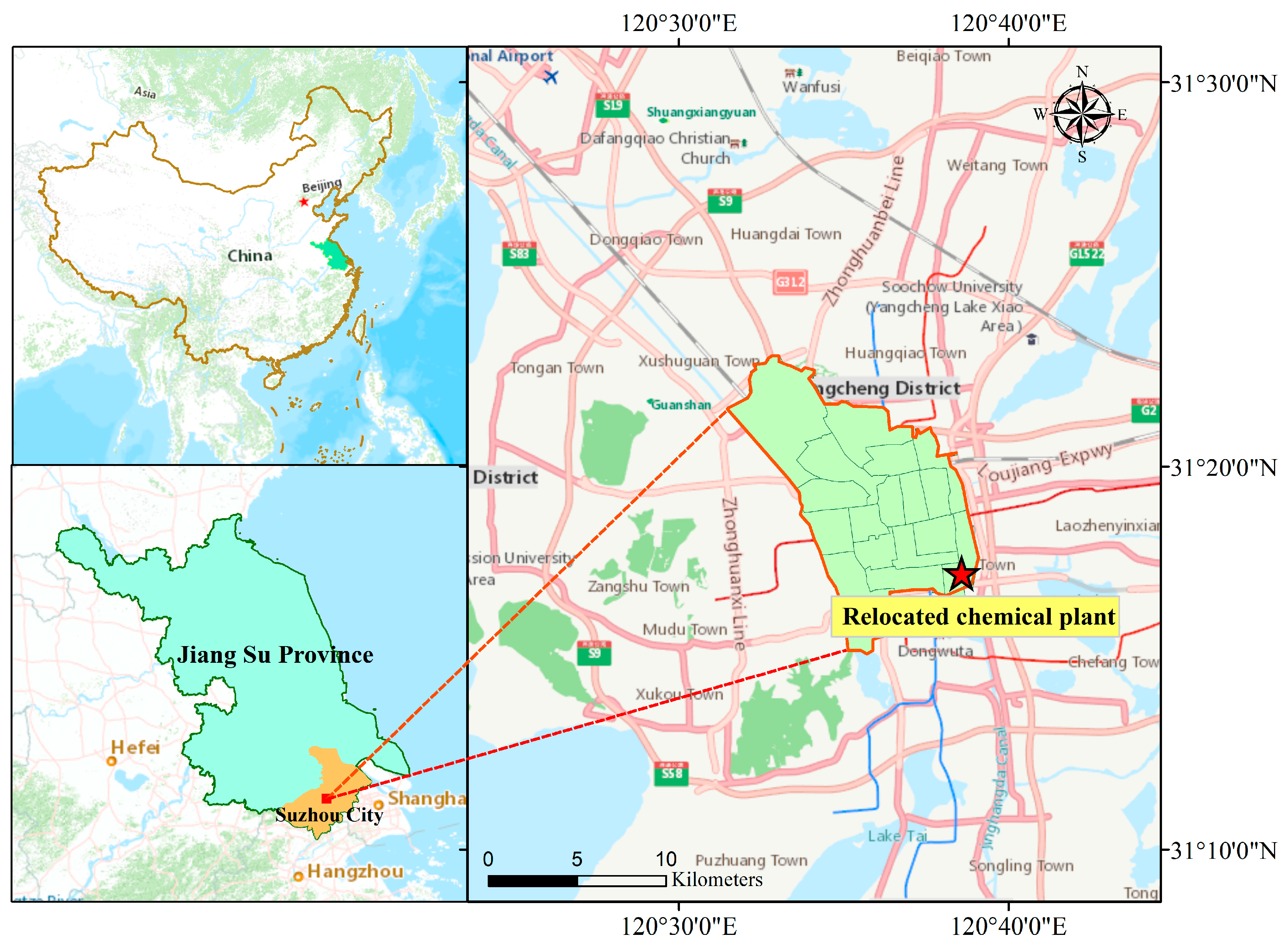

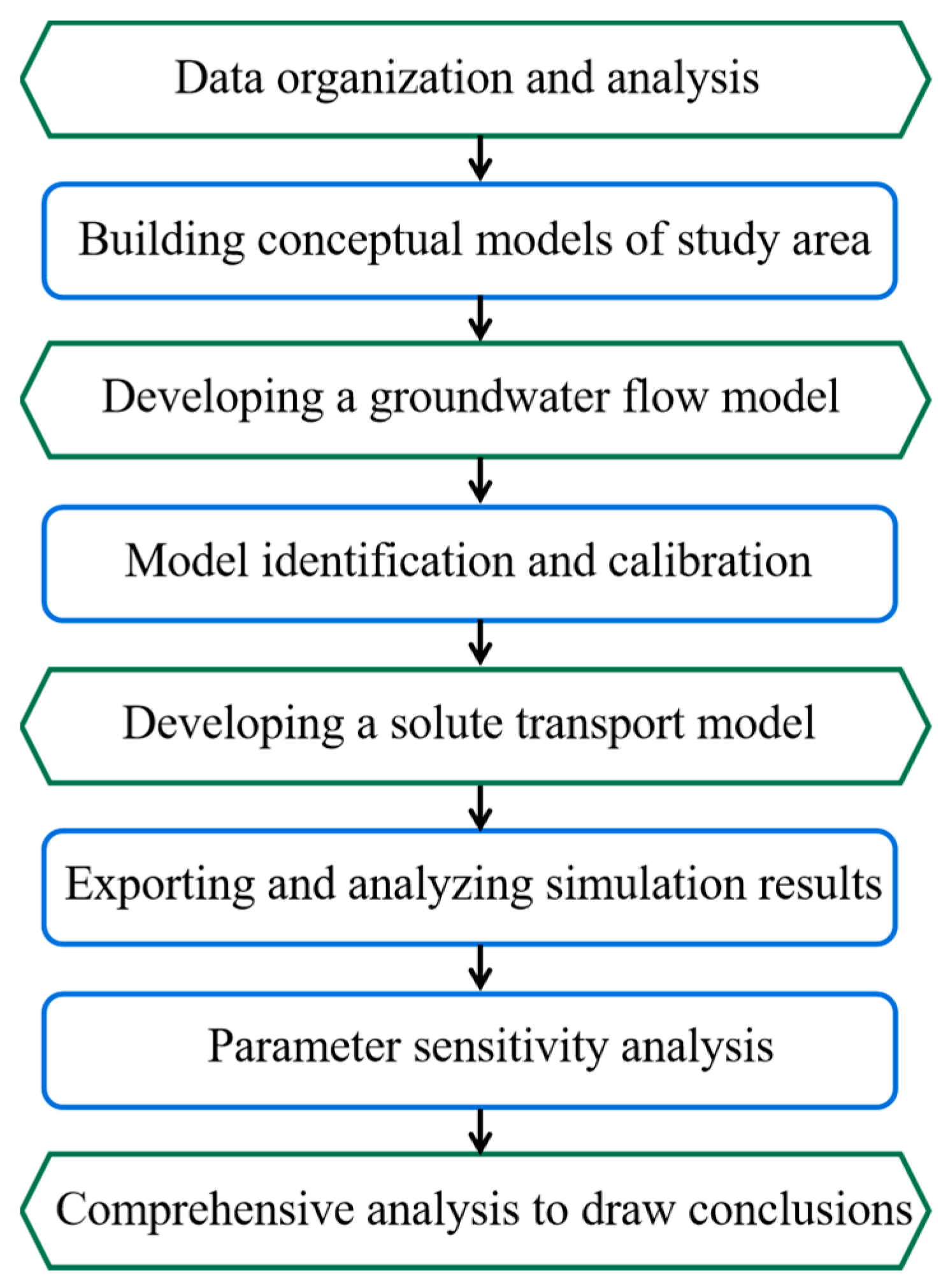
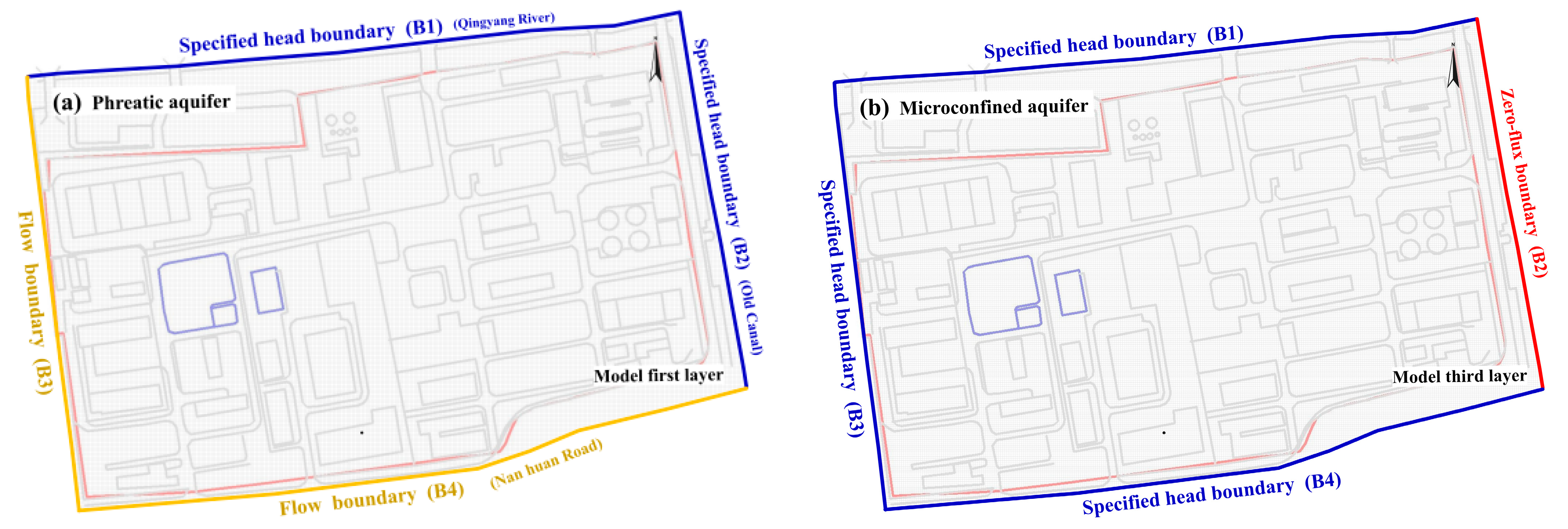
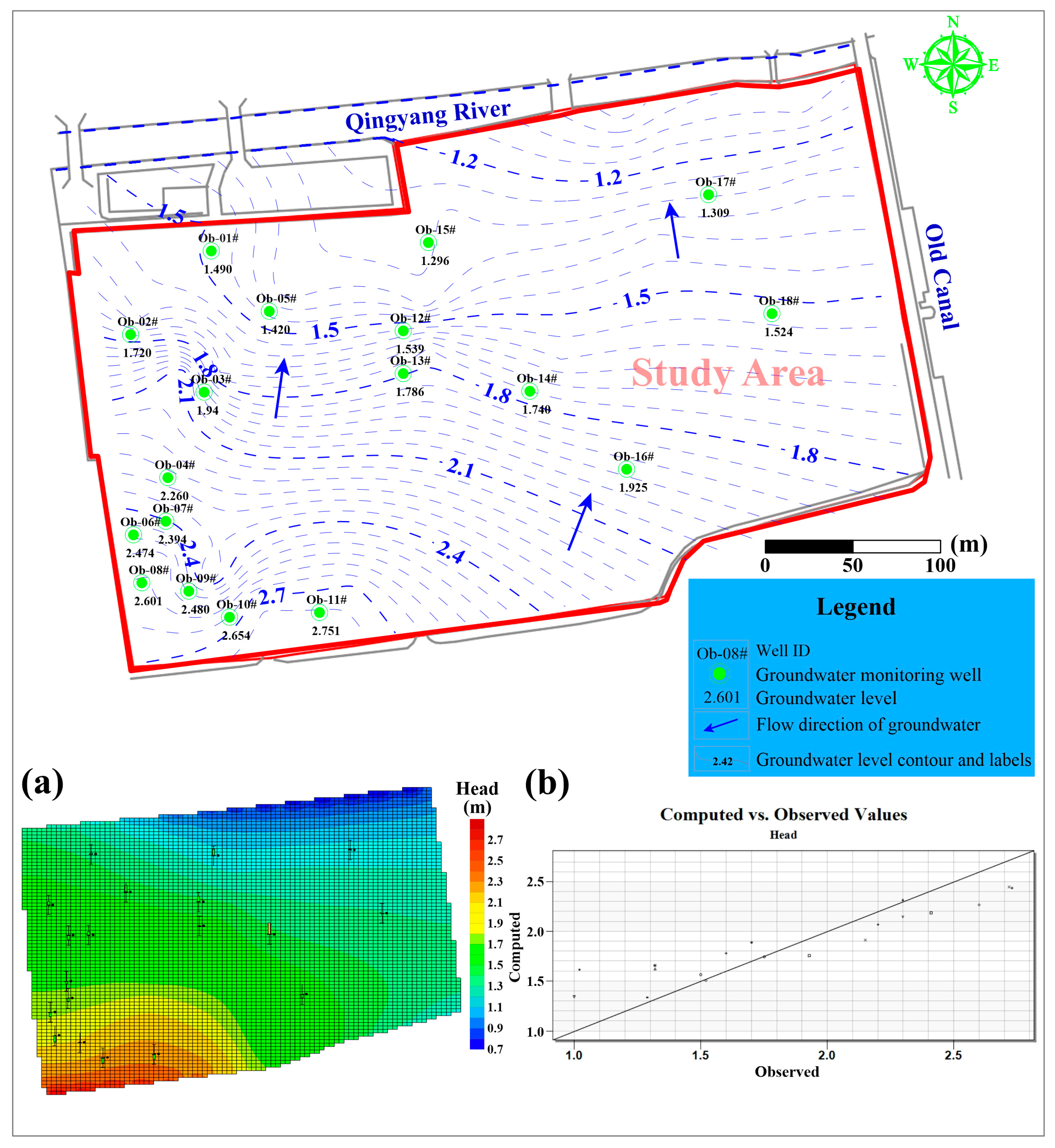
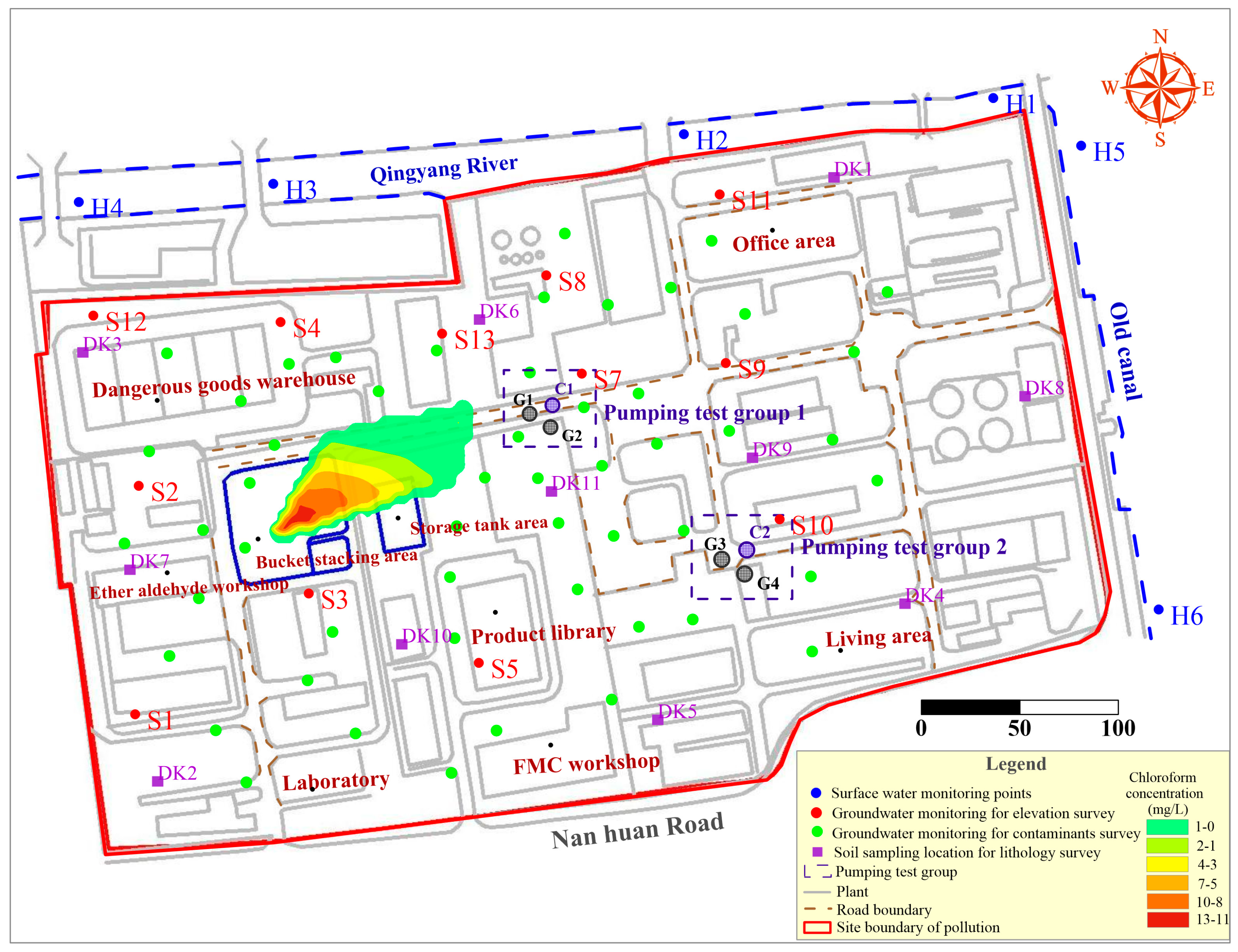
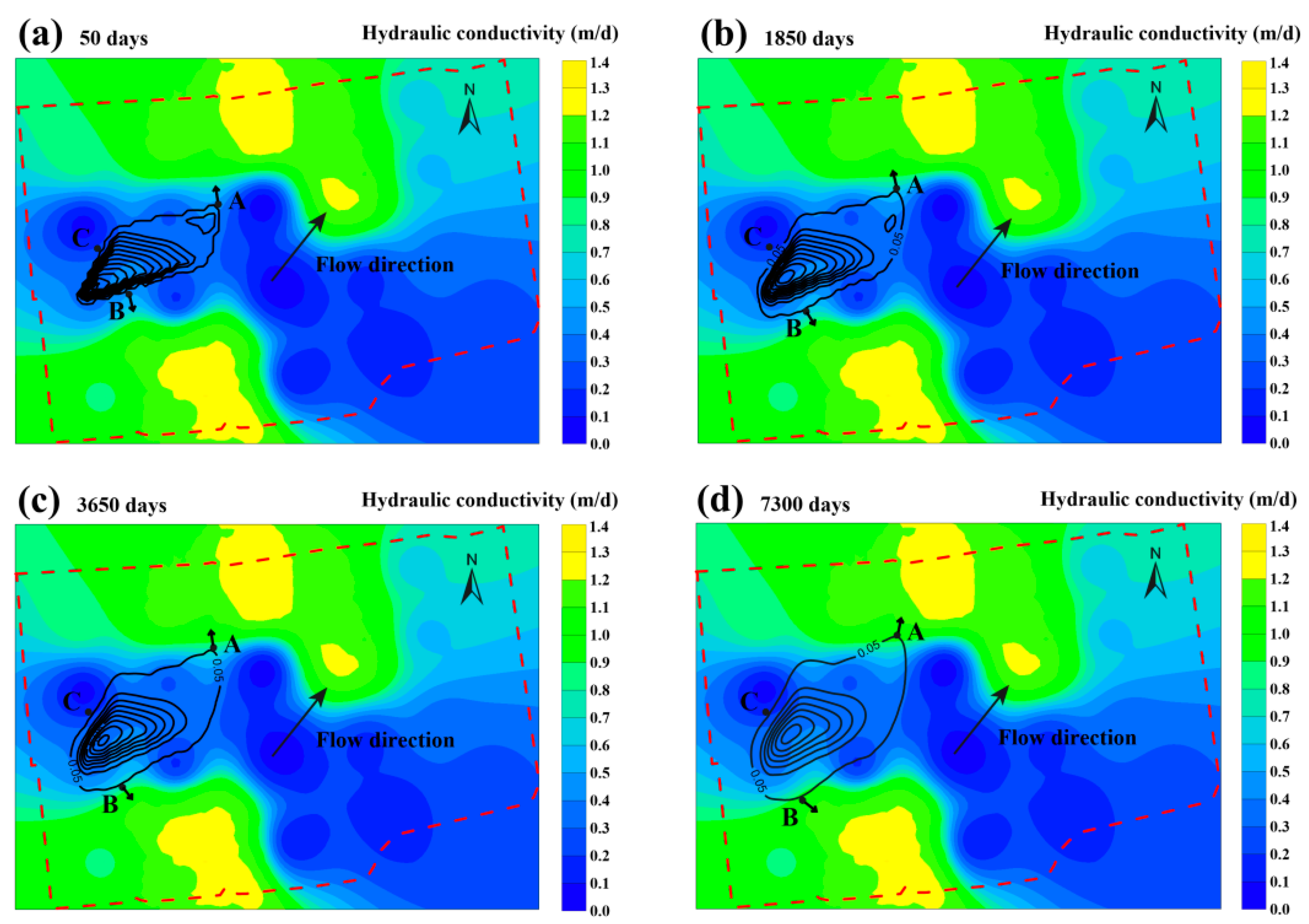
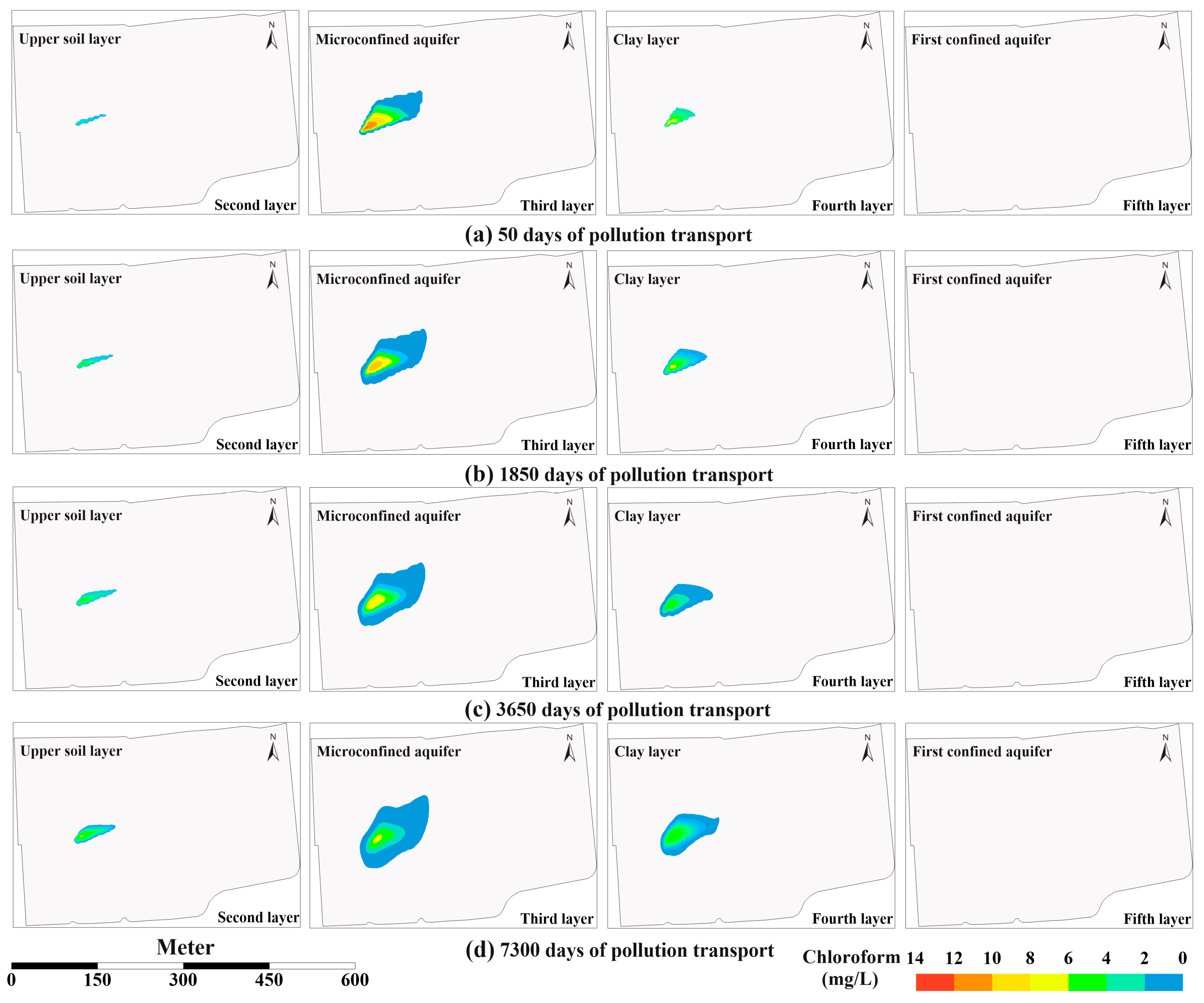
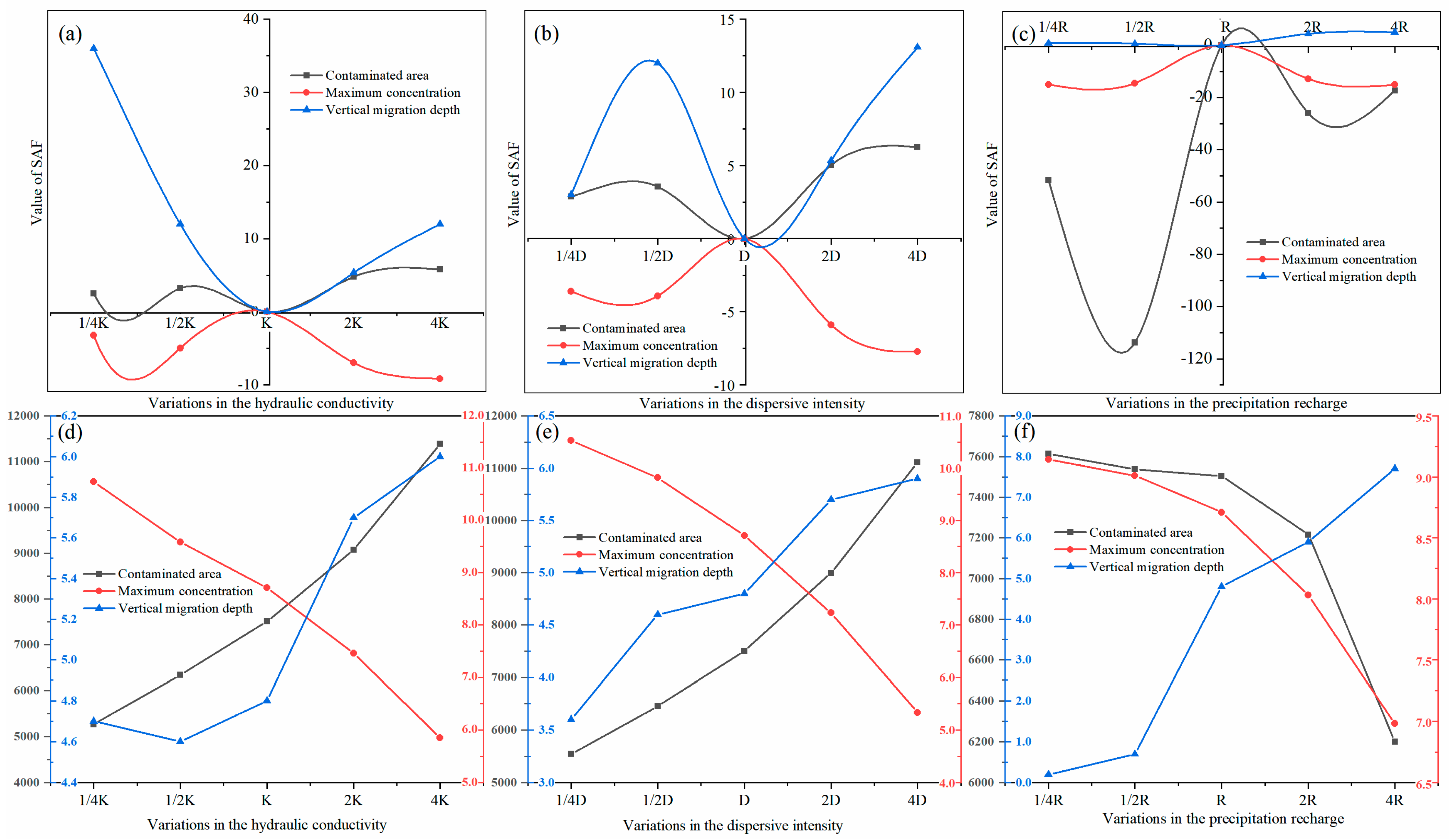
| Contaminants | Risk Control Value (mg/L) | Maximum Pollution Concentration (mg/L) | Maximum Exceedance Multiple | Main Distribution Depth (m) |
|---|---|---|---|---|
| Benzene | 0.84 | 87.36 | 103.00 | 5.00–15.00 |
| Carbon Tetrachloride | 0.13 | 16.13 | 125.00 | 5.00–15.00 |
| Chlorobenzene | 5.79 | 509.08 | 87.00 | 9.00–15.00 |
| Chloroform | 0.05 | 17.92 | 223.00 | 9.00–18.00 |
| Position | Order | r1 (m) | r2 (m) | M (m) | Q (m3/d) | S1 (m) | S2 (m) | R (m) | Permeability (m/d) | Average Value (m/d) |
|---|---|---|---|---|---|---|---|---|---|---|
| Group 1 | 1st time | 8.00 | 14.00 | 1.60 | 15.10 | 1.55 | 0.54 | 17.00 | 0.83 | 0.75 |
| 2nd time | 8.00 | 14.00 | 1.60 | 9.49 | 0.96 | 2.13 | 16.00 | 0.68 | ||
| 3rd time | 8.00 | 14.00 | 1.60 | 5.17 | 0.52 | 1.94 | 17.00 | 0.73 | ||
| Group 2 | 1st time | 6.00 | 12.00 | 2.00 | 8.44 | 1.57 | 0.65 | 14.00 | 1.06 | 0.85 |
| 2nd time | 6.00 | 12.00 | 2.00 | 5.65 | 1.02 | 1.62 | 14.00 | 0.74 | ||
| 3rd time | 6.00 | 12.00 | 2.00 | 2.87 | 0.52 | 1.43 | 14.00 | 0.75 |
| Layer Number | Horizontal Conductivity (m/d) | Vertical Conductivity (m/d) | Effective Porosity | Longitudinal Dispersity (m) |
|---|---|---|---|---|
| 1 | 0.0173 | 0.0259 | 0.483 | 10.0 |
| 2 | 0.0023 | 0.0031 | 0.427 | 8.0 |
| 3 | 0.7500 | 0.7000 | 0.464 | 15.0 |
| 4 | 0.0369 | 0.0420 | 0.469 | 10.0 |
| 5 | 0.7900 | 0.7530 | 0.486 | 20.0 |
| Migration TIME (day) | Contaminated Area (m2) | Variable Quantity (m2) | Maximum Concentration (mg/L) | Variable Quantity (mg/L) | Upward Migration Distance (m) | Variable Quantity (m) | Vertical Migration Depth (m) | Variable Quantity (m) |
|---|---|---|---|---|---|---|---|---|
| 50 | 4664.92 | 13.27 | 0.40 | 1.50 | ||||
| 1850 | 5767.56 | 1102.64 | 10.87 | −2.40 | 0.90 | 0.50 | 2.00 | 0.50 |
| 3650 | 6449.74 | 682.18 | 9.99 | −0.88 | 1.40 | 0.50 | 3.00 | 1.00 |
| 5450 | 7019.51 | 569.77 | 9.34 | −0.65 | 1.70 | 0.30 | 3.70 | 0.70 |
| 7300 | 7504.30 | 484.79 | 8.71 | −0.63 | 1.90 | 0.20 | 4.80 | 1.10 |
Disclaimer/Publisher’s Note: The statements, opinions and data contained in all publications are solely those of the individual author(s) and contributor(s) and not of MDPI and/or the editor(s). MDPI and/or the editor(s) disclaim responsibility for any injury to people or property resulting from any ideas, methods, instructions or products referred to in the content. |
© 2023 by the authors. Licensee MDPI, Basel, Switzerland. This article is an open access article distributed under the terms and conditions of the Creative Commons Attribution (CC BY) license (https://creativecommons.org/licenses/by/4.0/).
Share and Cite
Zhou, J.; Song, B.; Yu, L.; Xie, W.; Lu, X.; Jiang, D.; Kong, L.; Deng, S.; Song, M. Numerical Research on Migration Law of Typical Chlorinated Organic Matter in Shallow Groundwater of Yangtze Delta Region. Water 2023, 15, 1381. https://doi.org/10.3390/w15071381
Zhou J, Song B, Yu L, Xie W, Lu X, Jiang D, Kong L, Deng S, Song M. Numerical Research on Migration Law of Typical Chlorinated Organic Matter in Shallow Groundwater of Yangtze Delta Region. Water. 2023; 15(7):1381. https://doi.org/10.3390/w15071381
Chicago/Turabian StyleZhou, Jiang, Bing Song, Lei Yu, Wenyi Xie, Xiaohui Lu, Dengdeng Jiang, Lingya Kong, Shaopo Deng, and Min Song. 2023. "Numerical Research on Migration Law of Typical Chlorinated Organic Matter in Shallow Groundwater of Yangtze Delta Region" Water 15, no. 7: 1381. https://doi.org/10.3390/w15071381






